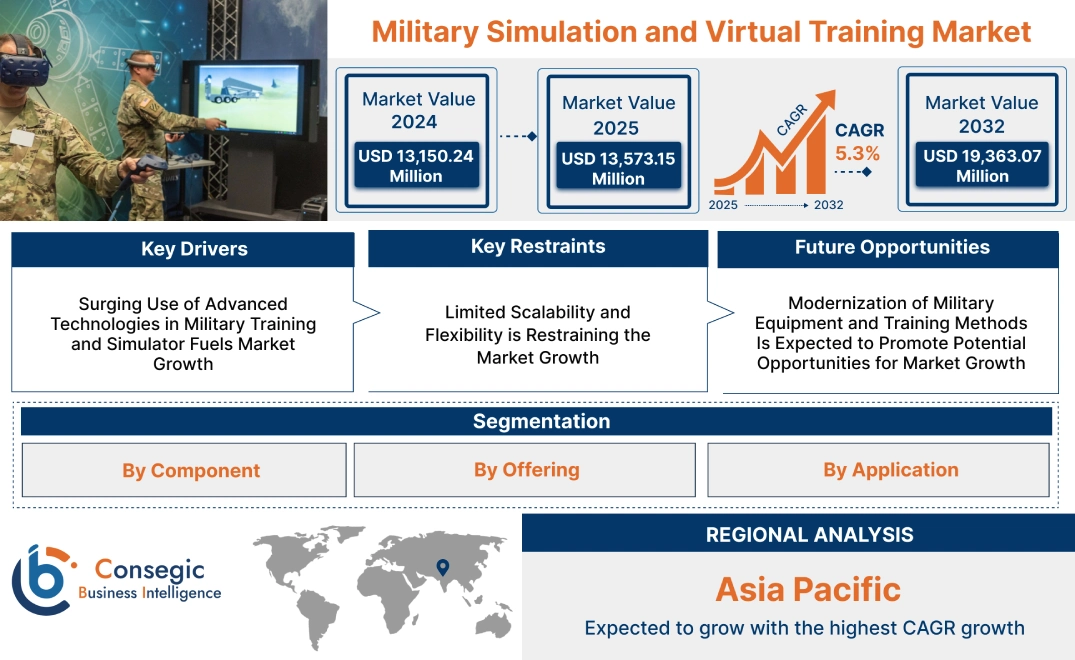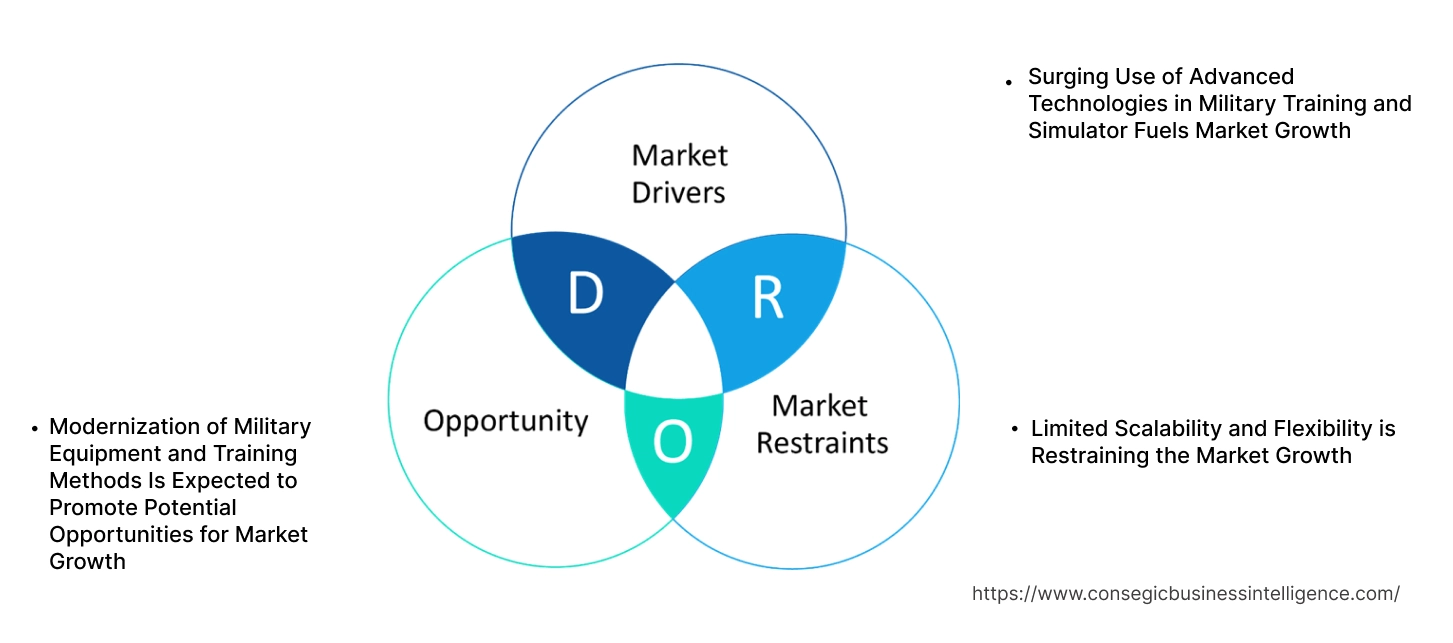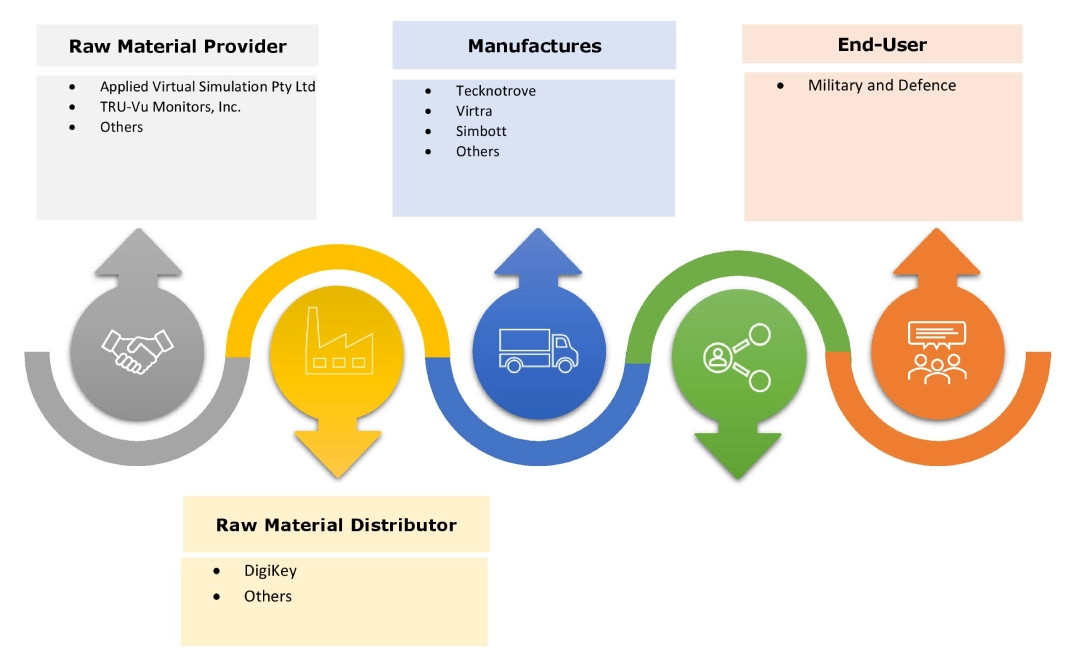- Summary
- Table Of Content
- Methodology
Military Simulation and Virtual Training Market Size:
Military Simulation and Virtual Training Market is estimated to reach over USD 19,363.07 Million by 2032 from a value of USD 13,150.24 Million in 2024 and is projected to grow by USD 13,573.15 Million in 2025, growing at a CAGR of 5.3% from 2025 to 2032.
Military Simulation and Virtual Training Market Scope & Overview:
Military simulation and virtual training are a combination of training and simulation with computer generated models and environments for immersive, interactive scenarios. The solution leverage advanced technology such as AR, VR, simulator devices and others to help soldiers make better decisions and ultimately lead to better outcomes in the field. Moreover, the training is designed to meet all kinds of training warfighting skills. Additionally, key advantages include increased safety, controlled training, flexible environment, immersive experience and cost-effective among others is driving the military simulation and virtual training market growth. Further, increasing border tensions is driving the adoption of simulator and virtual devices in training for planning and strategizing is driving the military simulation and virtual training market demand.
Key Drivers:
Surging Use of Advanced Technologies in Military Training and Simulator Fuels Market Growth
The training providers are increasingly leveraging 360 videos, augmented reality, virtual reality, mixed reality, and extended reality to immerse trainees in realistic military scenarios is driving the military simulation and virtual training market growth. Additionally, growing complexity of modern warfare is propelling defense organizations to focus on adoption of advanced technologies such as automation and artificial intelligence among others into training and simulation is driving the military simulation and virtual training market demand.
- For instance, in November 2023, BAE systems partnered with red hat and the weather company for redefining military simulation environments. The partnership aims to provide next-generation constructive simulation environments, digital twins of the earth for simulation, and the most advanced synthetic training environments.
Therefore, the growing complexity of modern warfare and rising adoption of advanced technology in military simulation and virtual training is driving the growth of the market.
Key Restraints:
Limited Scalability and Flexibility is Restraining the Market Growth
Military training and simulation are complex solutions used for storing, editing, or synchronizing data between each training session. Also, simulation programs are difficult to adapt training scenarios to address threats and changing operational scenarios which in turn is hampering the military simulation and virtual training market expansion. Further, platforms are limited in the number of trainees that accommodate which in turn restricts the military simulation and virtual training market expansion.
Therefore, the scalability and flexibility limitations in the military simulation and training are restraining the market growth.
Future Opportunities :
Modernization of Military Equipment and Training Methods Is Expected to Promote Potential Opportunities for Market Growth
The increasing cross border conflicts is driving the adoption of modernized military equipment and training methods which eventually increase the miliary expenditure in turn is driving the military simulation and virtual training market opportunities. Further, rising need for high-speed computers and advanced robotics to ensure global alignment in combatting threats is propelling the military simulation and virtual training market opportunities.
- For instance, according to the world bank group, North American military expenditure reached USD 943.2 billion which is 3.2% of GDP and Indian military expenditure reached 83.57 Billion which is 2.4% of GDP. Additionally, Isreal military expenditure reached 27.5 Billion which is 5.3% of GDP.
Hence, the increasing expenditure in the military and defence industry and rising cross border conflicts is anticipated to increase the utilization of modern equipment in military training in turn promoting prospects for market progress during the forecast period.
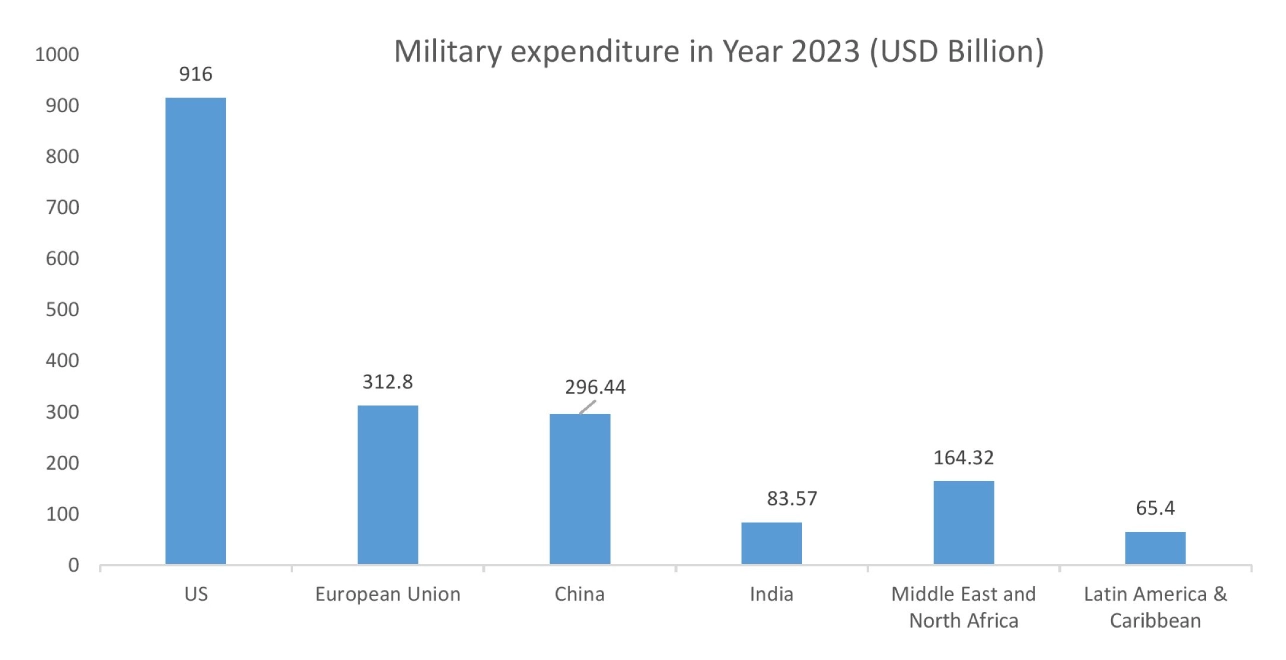
Hence, the increasing expenditure in the military and defence industry and rising cross border conflicts is anticipated to increase the utilization of modern equipment in military training in turn promoting prospects for market progress during the forecast period.
Military Simulation and Virtual Training Market Segmental Analysis :
By Component:
Based on the component, the market is segmented into hardware, software and service.
Trends in the Component:
- The demand for immersive and scenario-based training is driving the adoption of hardware component which in turn fuels the military simulation and virtual training market trend.
- The unpredictable geopolitical environment is driving the demand for simulators and virtual training which in tun is fueling the military simulation and virtual training market trend.
Hardware accounted for the largest revenue share in the year 2024.
- The hardware components in the market include simulation devices, virtual reality devices and other aiming to enhance tactical and strategical capabilities in the soldiers.
- Moreover, the key benefits of adopting hardware component in the military training include increased safety, immersive experience, realistic training and other is driving the segment progress which in turn is propelling the military simulation and virtual training market share.
- Further, the rising adoption of simulators and advanced technologies such as AR, VR and others is driving the hardware component which in turn is boosting the military simulation and virtual training market share.
- For instance, in July 2024, Rheinmetall deployed ausbildungs-ausstattung training navigation, which is a ship-handling simulators to German Navy. The simulator enhances interdisciplinary nautical training for all naval services throughout all ranks.
- Thus, according to the military simulation and virtual training market analysis, the aim to enhance tactical and strategic capabilities in the soldiers is driving the adoption of hardware components.
Service is anticipated to register the fastest CAGR during the forecast period.
- The aim of the service segment in market is to provide effectively and efficiently plan, design, review and manage your training scenarios in turn fuels the military simulation and virtual training market size.
- Further, the demand to provide maintenance services, and address product issues or defects is driving the adoption of services segment which in turn boosts the military simulation and virtual training market size.
- For instance, in June 2023, General dynamics information technology collaborated with flightsafety international company. The collaboration aims to provide services and support to the U.S. army’s aviation center of excellence. The services and support include necessary skills to overcome degraded visual conditions, system failures, and power loss.
- Therefore, according to the military simulation and virtual training market analysis, the aim to provide effectively and efficiently plan, design, review and manage your training scenarios is anticipated to boost the market during the forecast period.
By Offering:
Based on the offering, the market is segmented into air warfare simulator and training, air combat training simulation system, naval training, combat convoy training, military driver & route clearance training, fire incident command and control simulation training, close quarter battle, active threat/active killer and others.
Trends in the Offering:
- The trend towards reducing accident rates and increasing efficiency is driving the adoption of military driver & route clearance training.
- The trend toward increasing focus towards risk mitigation is driving the adoption of active threat / active killer simulators.
The air warfare simulator and training accounted for the largest revenue share in the year 2024.
- Air warfare simulator and training provide pilots with real-time immersive experience, which allow realistic evaluation of the pilots' combat skills and weapon utilization.
- Moreover, the key advantages include fast, accurate, adaptable, cost-effective and safe simulation environment for air warfare training which in turn is driving the market progress.
- Furter, the demand to provide the warfighter with the best training and tactical weapon system is driving the adoption of air warfare simulator and training.
- For instance, in November 2023, Vertex solutions collaborated with defense innovation unit to integrate an F-16 MR flight training device. The aim is to elevate military operational flight training with their first operational aircraft mixed reality simulator.
- Thus, as per the market analysis, the demand to provide the warfighter with the best training and tactical weapon system is driving the air warfare simulator and training segment progress.
The combat convoy training is anticipated to register the fastest CAGR during the forecast period.
- The ability provides an immersive training environment with advanced convoy skills using different terrains and roads in a variety of weather, visibility, and vehicle operational conditions for convoy operations is driving the need of the simulator.
- Further, the need to ensure that army personnel, whether a driver or an engineer, have the skills required to minimize risks is driving the adoption of combat convoy training.
- For instance, in December 2024, Viettel High-Tech Industries Corporation developed SU30-MK2 fighter jet simulation system aiming to increase efficiency in combat training for the Vietnam air defense.
- Therefore, as per the market analysis, the need to minimize risks is anticipated to boost the market during the forecast period.
By Application:
Based on the application, the market is segmented into land, air and naval.
Trends in the Application:
- The trend towards integration of AI into naval simulators to improve the conditions of modern warfare and strategic decision-making is driving the market progress in naval based applications.
- The air simulators are integrated with motion platforms and haptic feedback systems which replicate the physical sensations of flying is driving the market progress.
Air accounted for the largest revenue share of 56.23% in the year 2024.
- The aircraft simulators are preferred to train soldiers towards complex terrain and various weather conditions which in turn is driving the market development.
- Moreover, technological advancement such as AR, VR and others is driving the adoption in air applications which in turn is fueling the military simulation and virtual training industry.
- Further, the increasing defence budget and rising adoption of advanced aircraft is driving the need for aircraft simulators which in turn is boosting the market for air application.
- For instance, in September 2024, Super Dimona deployed aircraft simulators to NDA, India. The simulator features a 135 degree field of view for providing immersive display and realistic aerial experience.
- Thus, as per the market analysis, increasing defence budget and rising adoption of advanced aircraft is driving the adoption of simulators for training in air application.
Land is anticipated to register the fastest CAGR during the forecast period.
- The land application includes basic vehicle operating training to advanced tactical training for different vehicle types.
- Moreover, simulation includes operator driver training, operator driver desktop training, combat convoy training, and others are driving the adoption of simulators for land based applications.
- Further, the rising need of simulators by ground troop to train weapons, driving, combat practice and tactical skills in the safety of a simulation is driving the market development in land based applications.
- Therefore, as per the market analysis, the need to train weapons, driving, combat practice and tactical skills is anticipated to boost the market during the forecast period.
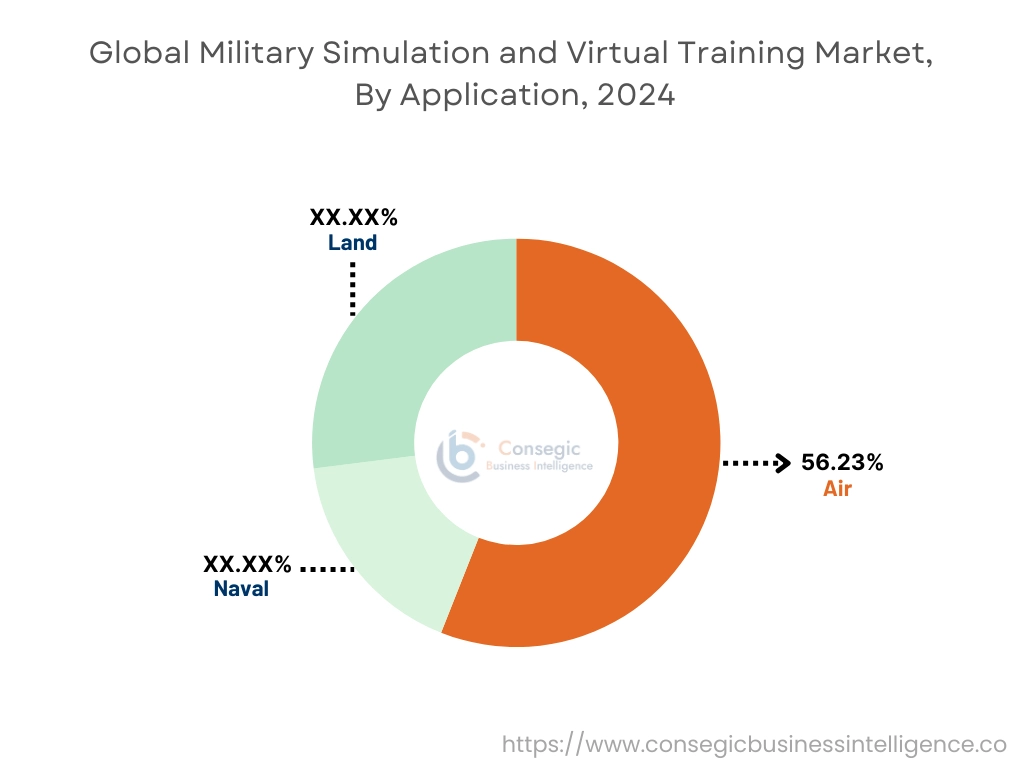
Regional Analysis:
The regions covered are North America, Europe, Asia Pacific, Middle East and Africa, and Latin America.
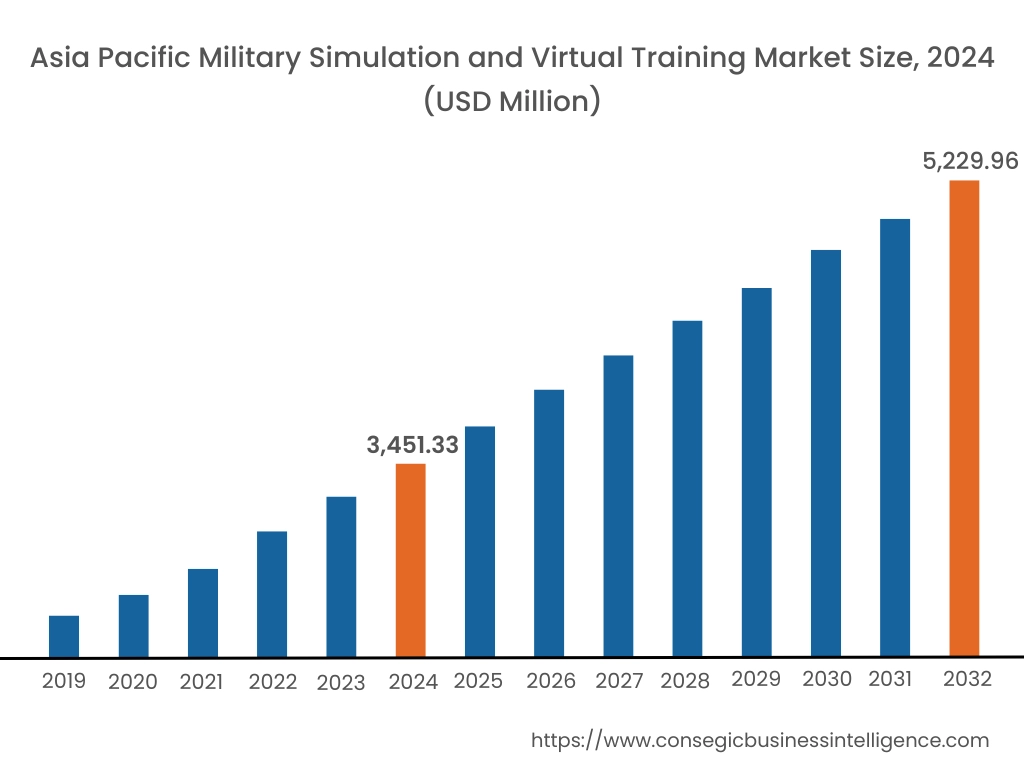
Asia Pacific region was valued at USD 3,451.33 Million in 2024. Moreover, it is projected to grow by USD 3,570.97 Million in 2025 and reach over USD 5,229.96 Million by 2032. Out of this, China accounted for the maximum revenue share of 34.5%. The market is mainly driven by its deployment in ground based simulation and training. Furthermore, factors including increasing defence budget and advancing military training methods are projected to drive the market progress in Asia Pacific region during the forecast period.
- For instance, according to Ministry of National Defense of the People's Republic of China, government has proposed a defense budget for FY 2024 of USD 231 which is an increase of 7.2 % year-on-year.
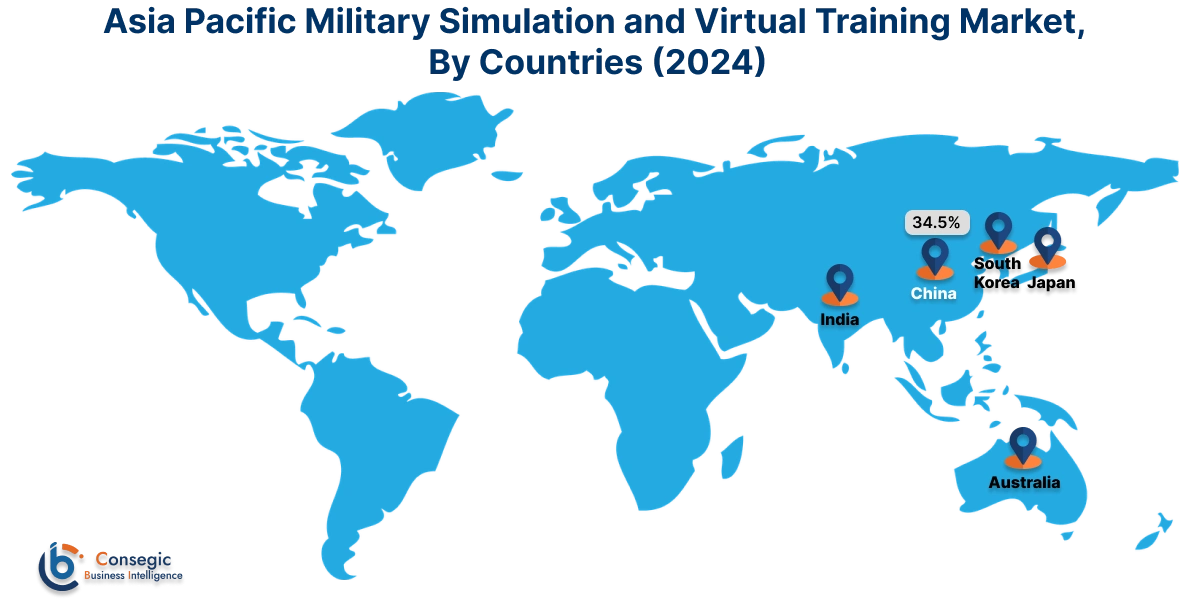
North America is estimated to reach over USD 6,761.58 Million by 2032 from a value of USD 4,573.28 Million in 2024 and is projected to grow by USD 4,721.97 Million in 2025. The North American region's increasing defence budget on Y-o-Y basis offer lucrative growth prospects for the market. Additionally, the adoption of advanced technologies in military training is driving the market evolution.
- For instance, in November 2024, General Dynamics Information Technology received USD 330 million by the U.S. Army for providing simulation based training support and services.
The regional evaluation depicts that the increasing adoption of naval simulation and training in Europe is driving the market Progress. Additionally, the primary factor driving the market in the Middle East and African region is the increasing focus towards improving responsiveness to threats and increasing investment in the advanced technologies in military and defence industry. Further, the rising focus towards countering narcotic efforts is paving the way for the progress of market in Latin America region.
Top Key Players and Market Share Insights:
The global military simulation and virtual training market is highly competitive with major players providing military simulation and virtual training to the national and international markets. Key players are adopting several strategies in research and development (R&D), product innovation, and end-user launches to hold a strong position in the military simulation and virtual training industry. Key players in the military simulation and virtual training market include-
- Crow King Studios, LLC. (USA)
- FAAC Incorporated (USA)
- Wescom Group (UK)
- Havelsan Inc. (Türkiye)
- Thales (France)
- Rheinmetall AG (Germany)
- Tecknotrove (India)
- Virtra (USA)
- Simbott (India)
- Zen Technologies Limited (India)
Recent Industry Developments :
Deployment:
- In February 2025, Rheinmetall deployed C-390 flight simulators to the royal Netherlands air force. The aim of the deployment is to train aircraft crews and ground personnel.
Partnerships & Collaborations:
- In January 2025, Bohemia Interactive Simulations collaborated with Rheinmetall AG to enhance the performance and effectiveness of modern simulation technologies to train the German army's medium forces.
- In January 2025, SkyAlyne and KF Aerospace partnered with Textron Aviation to provide components for a full flight simulator and flight training devices, manufactured by CAE.
Military Simulation and Virtual Training Market Report Insights :
| Report Attributes | Report Details |
| Study Timeline | 2019-2032 |
| Market Size in 2032 | USD 19,363.07 Million |
| CAGR (2025-2032) | 5.3% |
| By Component |
|
| By Offering |
|
| By Application |
|
| By Region |
|
| Key Players |
|
| North America | U.S. Canada Mexico |
| Europe | U.K. Germany France Spain Italy Russia Benelux Rest of Europe |
| APAC | China South Korea Japan India Australia ASEAN Rest of Asia-Pacific |
| Middle East and Africa | GCC Turkey South Africa Rest of MEA |
| LATAM | Brazil Argentina Chile Rest of LATAM |
| Report Coverage |
|
Key Questions Answered in the Report
How big is the military simulation and virtual training market? +
The military simulation and virtual training market is estimated to reach over USD 19,363.07 Million by 2032 from a value of USD 13,150.24 Million in 2024 and is projected to grow by USD 13,573.15 Million in 2025, growing at a CAGR of 5.3% from 2025 to 2032.
What specific segmentation details are covered in the military simulation and virtual training report? +
The military simulation and virtual training report includes specific segmentation details for component, offering, application, and regions.
Which is the fastest segment anticipated to impact the market growth? +
In the military simulation and virtual training market, the combat convoy training is the fastest-growing segment during the forecast period due to need to ensure that army personnel, whether a driver or an engineer, have the skills required to minimize risks.
Who are the major players in the military simulation and virtual training market? +
The key participants in the military simulation and virtual training market are Crow King Studios, LLC. (USA), FAAC Incorporated (USA), Rheinmetall AG (Germany), Tecknotrove (India), Virtra (USA), Simbott (India), Zen Technologies Limited (India), Wescom Group (UK), Havelsan Inc. (Türkiye), Thales (France) and others.
What are the key trends in the military simulation and virtual training market? +
The military simulation and virtual training market is being shaped by several key trends including integration of AI into naval simulators to improve the conditions of modern warfare and strategic decision-making as well as increasing focus towards risk mitigation is driving the adoption of active threat / active killer simulators are the key trends driving the market.
